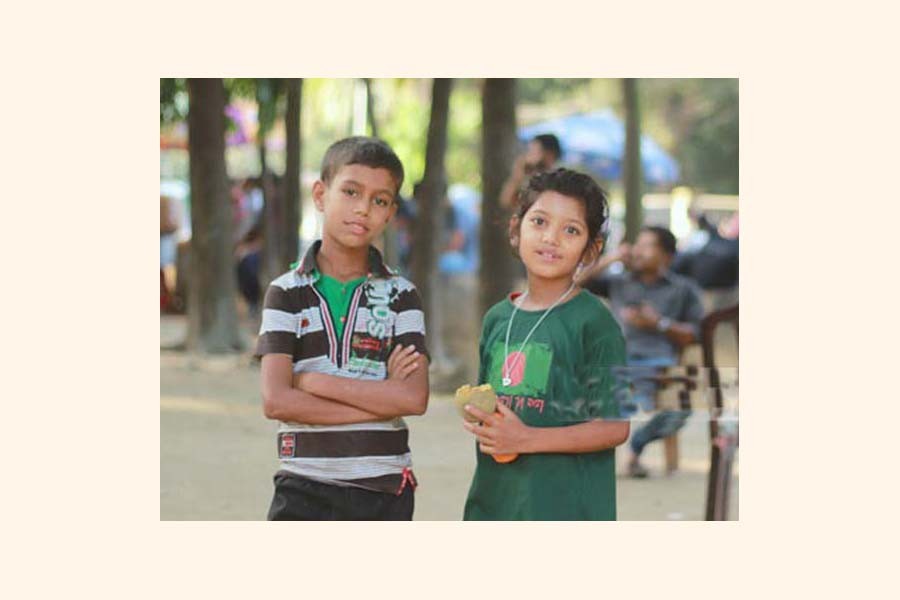
Street children stare into abyss
75pc do not have access to health care
Wednesday, 4 November 2020

Tahmid's mother Mariam Begum passed away while giving birth to his sister Antara. Their father Murad Hossain, a drug addict rickshaw-puller, lost his ties with family at the time. Their grandmother Hasina Khatun brought up both the siblings, reports bdnews24.com.
Khatun enrolled Tahmid in a school this year, but Tahmid did not like it. He began roaming on the streets with other children. Just like his father, he ended up living under the open sky. He currently lives on the Central Shaheed Minar premises.
Thousands of children in the Dhaka city live in the rail stations, bus terminals and outside the stadiums.
Losing their ties with the families due to different socio-economic troubles, these children are deprived of a proper childhood. They are known as 'street children.'
According to a 2004 survey by Bangladesh Institute of Development Studies (BIDS), the country had at least 1.3 million street children at that time.
The Ministry of Women and Children Affairs and the Department of Social Services refuted the survey, though they have not done one by themselves.
Five years have passed after Prime Minister Sheikh Hasina gave specific directives to the ministry for the rehabilitation of the street children at the inauguration of World Child Rights Week 2015.
The ministry and the Dhaka City Corporation have established the rehabilitation centres for the street children, but the initiatives have proved unsuccessful.
No efforts to resolve the issue will be fruitful without a long-term plan, believe top officials of the organisations working for the street children.
The ministry has now bolstered its strategy after long. It has sent proposed projects to the Ministry of Planning.
It was a quiet afternoon when he was selling flowers near the Teacher-Student Centre in Dhaka University. Four-year-old Emon said he had no proper place to live in. His father died long ago, while his mother married another man.
"I have no home. I used to live with my grandparents at a slum in Mirpur. They could not help me anymore and I began to live on the streets. Now I live in this park," the boy said.
The parents of Afrin (not her real name) got divorced when she was 10. When her grandfather died after another year, she and her grandmother moved from one place to another for a living. The 14-year-old and her grandmother now lives in the Shaheed Minar area.
"I could not keep her from spoiling," sighed Afrin's grandmother. Living on the streets for long brought an adverse effect to Afrin's life. She became a sex worker and also got addicted to drugs.
The father of Russel lost his job due to the coronavirus pandemic and began working as a farm worker in Tangail's Gopalpur, but his income was not enough to feed his three children.
The 2004 BIDS study has become obsolete now, said Abul Hossain, who heads the Cell on Street Children Affairs in the Ministry of Women and Children Affairs.
According to a 2005 survey by the Department of Social Services, 41 per cent of the street children do not have a bed to sleep on; 40 per cent do not have access to bathing facilities while 35 per cent defecate outdoors.
At least 84 per cent of these children do not have winter clothes and 54 per cent have no one to take care of them during sickness. As much as 75 per cent street children do not have access to health care.
A report by Bangladesh Shishu Adhikar Forum showed 85 per cent street children are addicted to drugs. They smoke and take heroin, different types of tablets and intravenous drugs.
At least 80 per cent of the street children work to make a living while 20 per cent confront physical abuse and 14.5 per cent face sexual assaults.
The Street Children Activist Network, or SCAN, conducted a survey on their living conditions in eight areas of the capital - Mohakhali, airport area, Kamalapur, Gabtoli and Sadarghat - from March 26 to 31.
The street children are passing their days in starvation now after losing their sources of income due to the pandemic, according to SCAN.
The street children are kept with adults at five vagrant centres run by the government, said Mahfuza Begum, additional director of social protection at the Department of Social Services.
Different quarters have appealed to the government for providing the street children with secondary education, but it has "no such plans" yet, said Habibur Rahman, director of Child Welfare Trust.
The trust also has no plan to ensure secondary education for the street children but it is pondering primary school infrastructural development and scholarships for them.
Every year, 220 students from the Trust schools are selected for scholarships. Once a student receives a scholarship, he or she can continue to have it until grade five provided they study regularly and produce good academic results.
The Trust has given the scholarship to 4,301 students in nine years until 2019.
Both city corporations of Dhaka have been running programmes for the street children in collaboration with a development organisation - Concerned Worldwide.